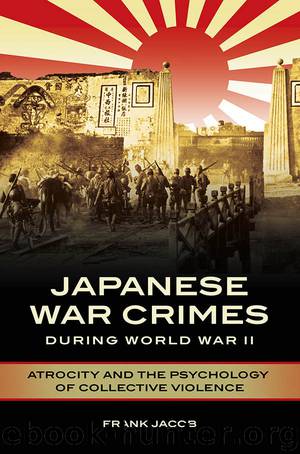Japanese War Crimes during World War II: Atrocity and the Psychology of Collective Violence by Frank Jacob

Author:Frank Jacob [Jacob, Frank]
Language: eng
Format: epub
Publisher: ABC-CLIO
Published: 2018-06-29T23:00:00+00:00
CHAPTER SIX
POWs of the Japanese
“Nobody knows what ‘Auschwitz’ is,
just as nobody knows what ‘labour camp’ is.
People vanish into both without a trace,
and that’s the last that is heard of them.”1
Yehiel De-Nur (1909–2001) was right in this evaluation about the lives and suffering of those who died during the Second World War in labor, concentration, or extermination camps under German or Japanese control. It is difficult to reconstruct the stories of those who perished in these camps, and many of them will never be told because only a minority of the victims survived. Although reports like the previously mentioned Dyess Story—which details the suffering of Allied POWs in Japanese camps—had been told, it took a while until they reached a broader public. On January 28, 1944, The New York Times published a story about the fall of Bataan and its aftermath based on the firsthand accounts of Commander Melvyn H. McCoy (U.S. Navy), Lieutenant Colonel S. M. Mellnik (U.S. Army Coast Artillery), and Captain William E. Dyess (Army Air Force), who had all “stunned their superiors with graphic descriptions of the savage treatment that the Japanese dealt out to helpless prisoners of war.”2 Yet these eyewitnesses were not allowed to report their stories immediately because President Roosevelt “feared that the disclosure of Japanese war crimes would provoke retaliation against American servicemen still in enemy hands”3 and therefore demanded that the news be suppressed.
However, when the report was released in January 1944, The New York Times emphasized the enemy’s barbaric nature: “The Japanese in war are not men we can understand. They are men of the old Stone Age, animals who sometimes stand erect.”4 The collected memories of the survivors of Japanese POW camps in Southeast Asia, especially the Philippines, represent what Gregory J. Urwin called “a catalog of horrors so monstrous that it still has the power to elicit intense emotional reactions.”5 It has already been mentioned that the Japanese forces were simply unprepared for a large number of POWs; dealing with so many surrendering soldiers was uncommon for the Japanese army, but this cannot be the only reason why 10,650 out of 25,580 Americans in Japanese hands would not see the end of the war and instead die “slow, agonizing deaths from complications brought on by malnutrition, dehydration, disease, and physical abuse.”6 Most of those who survived the camps developed physical and/or psychological trauma, particularly because they lived under the steady fear of violent abuse or death: “At any time, the Japanese proved capable of executing prisoners on the slightest pretext.”7
The discussion about POWs’ mistreatment in Japanese hands remains controversial because deniers maintain that they never mistreated prisoners, claiming that those accusing Japan have based their accusations on massacres without witnesses.8 Such views are strengthened by the fact that the “charges against the Japanese brought forward in the Tokyo War Crimes Trials were chilling,”9 regardless of the fact that there were survivors whose appearances alone attested to their treatment, like some who had survived the building of the Burma-Siam Railway:
That
Download
This site does not store any files on its server. We only index and link to content provided by other sites. Please contact the content providers to delete copyright contents if any and email us, we'll remove relevant links or contents immediately.
| Africa | Americas |
| Arctic & Antarctica | Asia |
| Australia & Oceania | Europe |
| Middle East | Russia |
| United States | World |
| Ancient Civilizations | Military |
| Historical Study & Educational Resources |
The Rape of Nanking by Iris Chang(3516)
The Sympathizer by Viet Thanh Nguyen(3481)
World without end by Ken Follett(3006)
Ants Among Elephants by Sujatha Gidla(2924)
Blood and Sand by Alex Von Tunzelmann(2608)
Japanese Design by Patricia J. Graham(2556)
City of Djinns: a year in Delhi by William Dalrymple(2136)
Inglorious Empire by Shashi Tharoor(2100)
Foreign Devils on the Silk Road: The Search for the Lost Treasures of Central Asia by Peter Hopkirk(2056)
In Order to Live: A North Korean Girl's Journey to Freedom by Yeonmi Park(2052)
Tokyo by Rob Goss(2018)
India's Ancient Past by R.S. Sharma(1987)
India's biggest cover-up by Dhar Anuj(1983)
The Great Game: On Secret Service in High Asia by Peter Hopkirk(1960)
Tokyo Geek's Guide: Manga, Anime, Gaming, Cosplay, Toys, Idols & More - The Ultimate Guide to Japan's Otaku Culture by Simone Gianni(1945)
Goodbye Madame Butterfly(1934)
The Queen of Nothing by Holly Black(1752)
Living Silence in Burma by Christina Fink(1728)
Batik by Rudolf Smend(1720)
